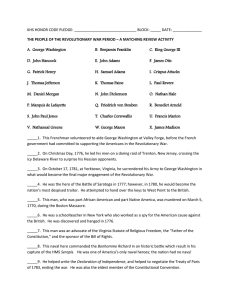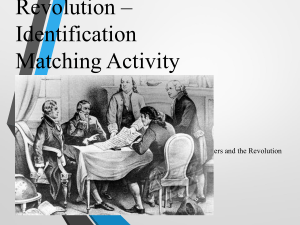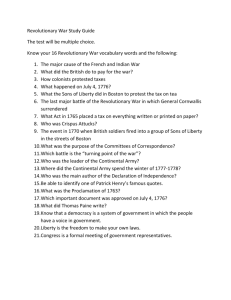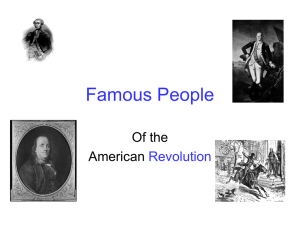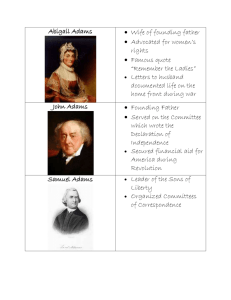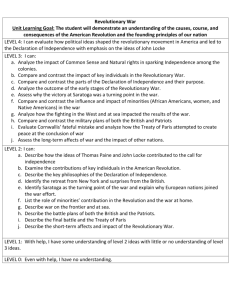The American Revolution * Identification Matching Activity - fchs
advertisement
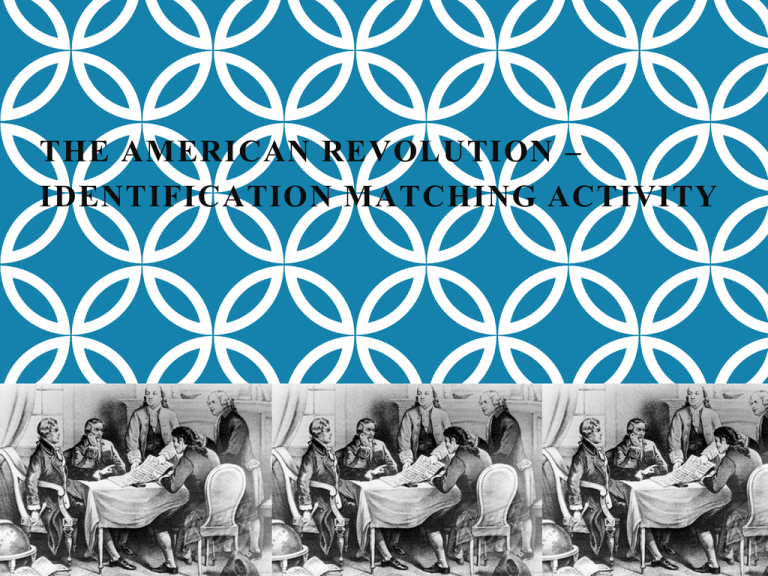
THE AMERICAN REVOLUTION – IDENTIFICATION MATCHING ACTIVITY The Founding Fathers and the Revolution A. GEORGE WASHINGTON On Christmas Day, 1776, he led his men on a daring raid of Trenton, New Jersey, crossing the icy Delaware River to surprise his Hessian opponents. Although he was the leading military figure of his day in the American colonies, Washington’s military track record left something to be desired. His blunders had helped to start the French and Indian War, and he was on the losing side of several major battles. B. BENJAMIN FRANKLIN He helped write the Declaration of Independence, and helped to negotiate The Treaty of Alliance with the French after the Battle of Saratoga. He also helped to shape the Treaty of Paris of 1783, ending the war with England... From which the United States won all of the territory east of the Mississippi River. He was the eldest member of the Constitutional Convention. Often, he is called the “Original American” man. C. KING GEORGE III He issued the Proclamation of 1763 after the French and Indian War came to a close; Americans were outraged that they would be denied access to the Ohio River Valley. Throughout the Revolutionary War Era, Americans were frustrated with the lack of involvement of the Crown in protecting their rights. After the war, mental illness would destroy the King’s good health. D. JOHN HANCOCK He was a well-known smuggler of sugar, molasses, and rum, and served as the mayor of Boston. He was arrested by the British for his smuggling. He affixed his signature to the Declaration of Independence in grand form, so that the King might see it better. E. JOHN ADAMS He defended the soldiers accused during the Boston Massacre; yet he was a strong advocate for independence. He authored the Declaration of Rights and Grievances as a member of the First Continental Congress, and served as a diplomat during the Revolutionary War. He was one of the committee of men selected to write the Declaration of Independence in 1776, but deferred to most of what Thomas Jefferson penned. F. JAMES OTIS He coined the phrase, “No Taxation Without Representation!” By the end of the Revolutionary War period, he suffered from dementia, and he has been neglected by history. But during the Revolutionary War Era, he was remembered fondly by most of the Founding Fathers, who uniformly endorsed his battle cry! G. PATRICK HENRY This member of the Virginia House of Burgesses was enraged by the occupation of Boston by British soldiers in 1774. He stormed, “I know not what path others may take, but as for me, give me liberty or give me death!” In many ways, Henry was committing an act of treason when he spoke out so rashly. Yet, based on his mixed record for bravery and defensive explanation, Henry probably would have avoided death at all cost if he were ever put on trial to defend himself… H. SAMUEL ADAMS He was the leader of the Sons of Liberty and one of the principle organizers of the Boston Tea Party. Today, his is sometimes remembered as “Brewer, Patriot…” During his time, though, he was considered the champion of the common man. He did not always publically approve of the methods used by committees of justice or the Sons of Liberty themselves; however, he understood that men who had been much frustrated in exercising their rights might need to resort to direct action. I. CRISPUS ATTUCKS This man, who was part AfricanAmerican and part Native America, was murdered on March 5, 1770, during the Boston Massacre. He was a free man, and a dockworker in Boston. Also killed at the Boston Massacre: Mr. Samuel Gray, rope-maker. Mr. James Caldwell, ship mate. Mr. Samuel Maverick, teenager. Mr. Patrick Carr, leatherworker. Mr. Christopher Monk, who died ten years later of wounds from the Boston Massacre… J. THOMAS JEFFERSON He was the author of The Declaration of Independence. He also contributed the Virginia Statute of Religious Freedom, an important contribution which served as a precursor to the First Amendment. During the fighting of the American Revolution itself, Jefferson was not distinguished for his role. As governor of Virginia, he surrendered and fled. Later, he was assigned to diplomatic duties during the Revolutionary War. K. THOMAS PAINE He was the author of both Common Sense, which encouraged Americans to claim Independence, and The American Crisis, which encouraged the Continental Army to fight on! Thomas Paine, however, was not an American by birth. Indeed, he was an English corset-maker by trade, and applied himself to the cause of liberty across the glove during his lifetime. L. PAUL REVERE His etching of the Boston Massacre was a piece of wildly inaccurate propaganda. And his role in the midnight ride to warn the men of Lexington and Concord to prepare for battle was much exaggerated, too. First of all, he was not alone. There were at least two others warning the minutemen of Massachusetts that the British were on their way. Secondly, some accounts suggest that Revere may have been quite polluted by the end of the “Midnight Ride…” “THE BOSTON MASSACRE” PAUL REVERE Paul Revere is best remembered as the messenger who warned minutemen in Lexington and Concord that “The Redcoats are Coming!” His more important role, though, was as the artist of this piece of propaganda material… The real Boston Massacre DID NOT look like this! M. DANIEL MORGAN His riflemen were extraordinarily influential during the Revolutionary War, playing decisive roles in the battles at Saratoga – a turning point in the Revolutionary War – and at the Battle of Cowpens during the Southern campaign. The men used guerrilla tactics, including “Turkey Calls” to organize ambushes against the British during the war. N. JOHN DICKENSON He was the author of the Olive Branch Petition in 1775, one of the last ditch efforts made by the First Continental Congress to avoid war with England. As close to a Tory as any American Revolutionary could be, Dickenson went out of his way to make certain that the British would be granted every opportunity to make amends and reconcile with their Americans colonists before supporting the War for Independence. John Adams could not endure him! O. NATHAN HALE He was a schoolteacher in New York who also worked as a spy for the American cause against the British. He was discovered and hanged in 1776. Nathan Hale is perhaps most famous for his defiant statement to the British as he was being led to his execution: “I regret that I have but one life to give for my country!” P. MARQUIS DE LA FAYETTE This Frenchman volunteered to aide George Washington at Valley Forge, before the French government had committed to supporting the Americans in the Revolutionary War. Without the support of the French, the United States would have had no military expertise, no navy, and in all probability, no victory during the Revolutionary War. Q. BARON FRIEDRICH VON STEUBEN This Prussian military man had padded his resume a bit before joining George Washington and the Continental Army at Valley Forge. It turns out, all of the military experience he claimed to have gained as a member of the Prussian Army was fictitious. Nevertheless, he was very skilled at training soldiers. Long after the war, their rumor persist that Von Steuben may have been homosexual. The attitudes of the period towards gay rights means that little evidence supports the claim today. R. BENEDICT ARNOLD He was the hero of the Battle of Saratoga in 1777; however, in 1780, he would become the nation’s most despised traitor. He attempted to hand over the keys to West Point to the British. Today, “Benedict Arnold” is an insult in many societies – indicating that one is a traitor to one’s friends and signifying the worst form of betrayal. S. JOHN PAUL JONES This naval hero commanded the Bonhomme Richard in an historic battle which result in his capture of the HMS Serapis. He was one of America’s only naval heroes; the nation had no navy! Not to be confused with (a) the rich donor who sent U.Va a lot of money for the naming rights to their new basketball arena, or (b) the bassist for Led Zepplin! JOHN PAUL JONES T. CHARLES CORNWALLIS On October 17, 1781, at Yorktown, Virginia, he surrendered his Army to George Washington in what would become the final major engagement of the Revolutionary War. Cornwallis had left the Southern campaign and moved his army to the North in hopes of drawing the enemy rebels to ground he could better defend. Ironically, the peninsula at Yorktown afforded Americans and their French allies the perfect place to coordinate their plans. U. FRANCIS MARION Known as the “Swamp Fox,” this man led Patriot forces in South Carolina against loyalists. The lead character in the film “The Patriot” is based – very loosely – on this man. Today, Marion is considered one of the great Revolutionary War heroes in South Carolina. The guerrilla style warfare which his men employed was not considered “civilized” at the time; however, it was the Americans only chance at victory! V. NATHANEAL GREENE After taking over the Continental Army’s southern brigade – replacing Horatio Gates – he kept Charles Cornwallis on a merry chase from King’s Mountain to Cowpens to Guilford Courthouse. Nathaneal Greene is better remembered today for his role in the Southern Campaign – fighting against Cornwallis and the British Army – in the American South. W. GEORGE MASON He was the author of the Virginia Declaration of Rights, which was added to Virginia’s Constitution, and served as a precursor to the Bill of Rights. Although a devoted and patriotic American, he refused to support the ratification of the Constitution due to his concern for the rights of men. He insisted that a Bill of Rights be added to the document before he would approve it. X. JAMES MADISON This man was an advocate of the Virginia Statute of Religious Freedom, the “Father of the Constitution,” and the sponsor of the Bill of Rights. James Madison would go on to become the fourth President of the United States, but his influence on American History was already profound before he won election. Madison was closely associated with Thomas Jefferson and was frequently conferred with when questions about the “Founding Fathers” true intentions were asked.
